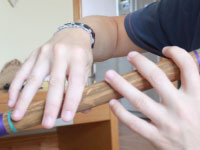STEP 1:
Buy a Bansuri (Bamboo Flute) of medium size – preferably C or G Scale to begin with.
STEP 2:
If you can produce a sound from Bansuri, good. If not, then keep it aside and pick up a Pen Cap. Place the open part on your lower lip. Blow air into it. Keep doing it until you get a clean whistling sound from it.


STEP 4 (Holding the Bansuri) :
Once you are able to produce sound from your Bansuri, close all the six holes with your first three fingers of both the hands. Use thumbs to hold the Bansuri. Your grip should neither be too tight nor too loose. The pinkies (little fingers) are not used while playing north-Indian Bansuri.

STEP 5 (Playing Pancham = P) :
Now gently blow into the blowing hole to get a sound. With all holes closed, you will get the sound of Pa (Pancham). Once you are able to get a clean sound with no hissing, try and blow with a steady breath for as long as you can. Initially you might not be able to blow continuously for 5 seconds, but gradually you will be able to blow for 15-20 seconds of even more depending upon your practice.

STEP 6 (Playing Shuddh Dhaiwat = D) :
Gently blow into the blowing hole with top 5 holes closed. Lift your bottom hand’s pinky just enough to uncover the hole. do not lift it too much away from the hole. You will get the sound of Dha (Dhaiwat). Keep practicing until you get a clean sound of Dha.

STEP 7 (Playing Shuddh Nishad = N) :
Gently blow into the blowing hole with top 4 holes closed. Lift your bottom hand’s ring finger and pinky just enough to uncover the last two holes. Do not lift them too much away from the holes. You will get the sound of Ni (Nishad). Keep practicing until you get a clean sound of Ni.

STEP 8 (Playing Shadaj = S) :
Gently blow into the blowing hole with top 3 holes closed. Lift your bottom hand to uncover the last three holes. Do not move too much away from the holes. You will get the sound of Sa (Shadaj). Keep practicing until you get a clean sound of Sa.

STEP 9 (Playing Shuddh Rishabh = R) :
Gently blow into the blowing hole with top 2 holes closed. Lift your bottom hand and ring finger of top hand to cover just the top two holes. You will get the sound of Re (Rishabh). Keep practicing until you get a clean sound of Re.
STEP 10 (Playing Shuddh Gandhar = G) :
Gently blow into the blowing hole with just the top hole closed with your first finger. You will get the sound of Ga (Gandhar). Keep practicing until you get a clean sound of Ga.
STEP 11 (Playing Shuddh Madhyam = M) :
This is a tricky note to play on Bansuri. Because unlike other notes where you have to cover/uncover the holes fully, but for playing Shuddh Madhyam, you need to cover/uncover just half of the top hole. Gently blow into the blowing hole to get the sound of Shuddh Ma (Madhyam). Keep practicing until you get a clean sound of Ma.

2 thoughts on “How to play Bansuri (Bamboo Flute)”
Nice, but you’ve made mistakes with “pinky” and “ring finger”. You interchanged the two at some places. It could get confusing.
Thank you, I’m new at this D5 Dobani flute.